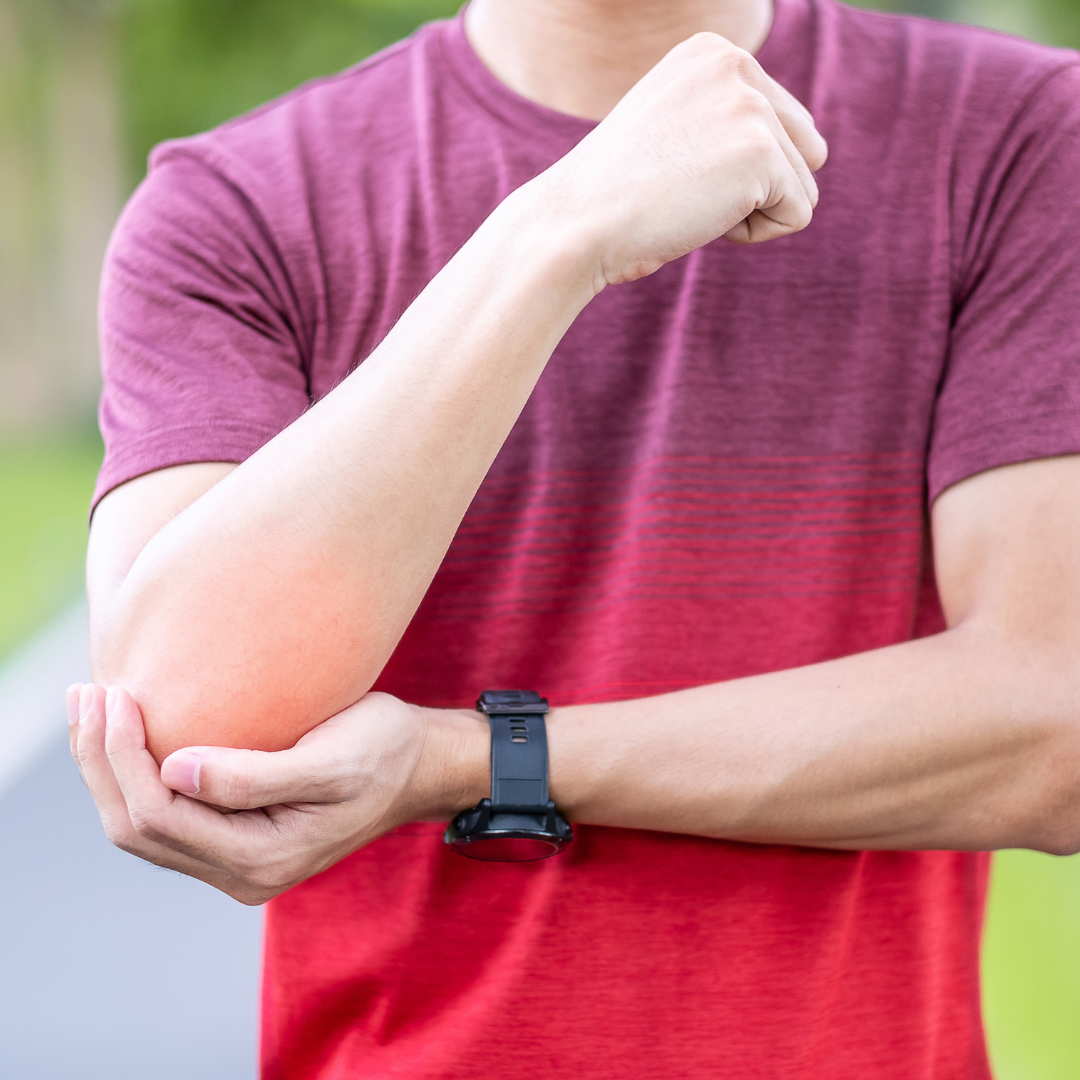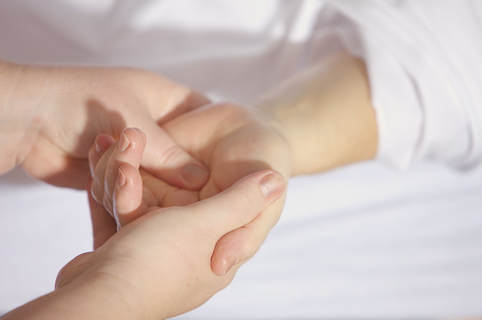|
‘Golfer’s and ‘Tennis Elbow’ are common complaints when it comes to those suffering from elbow pain, and yes it certainly happens even in people who don't play the sports these conditions take their nicknames from. Firstly, yes there is a difference between Tennis Elbow and Golfers Elbow, which is that one occurs at the outside of the elbow (Tennis Elbow) whereas the other occurs at the inside (Golfers Elbow).
The other difference is of course implied in the names in that they are often brought on by different repetitive activities that involve movements of the elbow - but its not limited to just tennis or golf. Beyond these distinctions however, is what they have in common, which is that they are both tendon overuse injuries, and that they are either going to be from the over-gripping activities which will require the muscles at the palm-side of the forearm, or else from the overextending activities of the wrist which will require the muscles at the backhand side of the forearm. And in case you haven't already guessed it, yes either of these muscle groups is connected to either side of the elbow! The best approach in terms of hands-on treatments with these types of injuries is to focus less work on the tendons themselves and rather more on all the muscles and muscle groups that join up with the tendons involved. This is because if the muscle tension at those specific muscles can be reduced it will relieve some of the tension at the tendons as well and essentially ‘de-load’ them, which can subsequently give them the time off they need to heal while not being constantly re-aggravated by the forces pulling on them. While most people often think of massaging sore areas, tendons that are already acutely inflamed actually don't love being directly worked on. Being tendon injuries, or what we call Tendinopathies (formerly Tendinitis/Tendinosis), they are usually an overuse type injury rather than acute (although an initial acute or sudden trauma/injury to a tendon can also lead to more chronic tendinopathies too), meaning that they usually come about as the result of repetitive use. For example, in this case, a builder having to use power tools for long periods and needing to grip tightly with their hand/s to maintain a stable hold while it moves and vibrates. All of this can stress and strain the tendons, and so it's important to remember that, due to the nature of the injury mechanism, we want to try and limit the forces on tendons as much as possible so as not to exacerbate them. So although we can work on muscles to reduce their potential strain on the tendons, it’s also necessary to reduce the loads on them in general, which could look like taking more regular but shorter work breaks, switching between different tasks and/or tools, using lower settings on machines and tools where possible, and being conscious of how hard you might be gripping / how much tension you really need to use vs how much you can relax as you maintain the task at hand. Anti inflammatories can be really helpful for this type of pain. We know a lot of patients who see us don't like to use medications, but tendon injuries are one type of condition that really responds well to that extra anti inflammatory support. By taking an anti inflammatory medication (as directed by your GP or pharmacist!) you can reduce the pain of your tendon and give yourself a chance to complete some of the pain relieving exercises we suggest. If you don't want to take anti inflammatory tablets, you can use a topical cream rubbed straight into the elbow. Also using ice on the tendons after a hard day to bring the inflammation back down and give them more time to recover during the night can be valuable. Another brilliant strategy with these elbow tendon issues is to use an elbow brace. Its an easy to use, affordable option that provides your angry tendon with a chance to take a break. The brace wraps around your forearm, and has a pressure point imbedded into it that you position over the area where the muscle and tendon connect, and this brace allows us to take load off the tendon by forming a new mechanical tension point. When you're wearing the brace, the muscle now moves from the brace to its other insertion point at the wrist, and gives the elbow attachments a recovery window. Our practitioners can help you fit the brace in the correct position for your pain. Lastly, once the initial symptoms are under control it’s a good idea to start rehabbing and building up strength and endurance of the muscles and tendons so as to ensure they have the capacity to do the work required of them. Using graded exercise is typically an important part in the actually healing process of the tendon repair too, as it helps to ensure that not only they build their capacity, but that they remodel and realign the tissues fibres and heal properly with less likelihood of reinjury by regaining some of there elastic and tensile properties. Tendons go really well with loaded exercises, but of course we need to get the weight level right for you. If you're already someone who has a lot of strength, you may start at a higher resistance level, but if you try to go too heavy too quick, that tendon can get very upset again. Our practitioners can help you with a quick daily exercise program that gets your tendon healthy again. Tendons can take time and persistence. You'll see us frequently at first while we get the pain levels under control, but our ultimate aim is to get you to the rehab stage where you follow the exercise program to rebuild strength. You may also experience a "stepping forward, stepping back" type of recovery with a tendon issue, because that area can get sensitised easily. We are here to help and support you through the process. If elbow and forearm pain has been getting in the way, please come and see us, we are here to help. Just call or leave a message with us at the Simple Wellness Myotherapy clinic here in Rowville on 03 8204 0970, or alternatively you can visit our website to see our booking schedule and make an appointment yourself for a time that best suits. If you work at a desk for hours on end, you know that it can be uncomfortable at the best of times. Office workers have just as much risk of injury and chronic pain as other more physically strenuous occupations. You may be at risk of issues including back pain, neck pain, repetitive strain injury or RSI and carpal tunnel syndrome.
So how can you minimise your chance of hurting yourself and stay at the top of your game? Our myotherapist Emily shares some of her tips for staying healthy and preventing pain and injury for office workers. Stretch often When you’re focused on your work, you often forget to shift position. Unfortunately, our bodies weren’t designed to stay in a position for hours at a time. That’s why the simplest tip is to stretch whenever you feel stiff, sore or fatigued. Stretching can also help to boost blood flow to the brain, which means you are more focused and productive. You can simply stretch at your desk if needed – stretch out your neck, shoulders and back, and do some circles with your ankles. But you can also do a standing stretch, which brings us to our next tip. Set yourself reminders to move Small amounts of movement throughout the day add up when it comes to preventing office injuries. But when you’re in the zone, you might forget! That’s why it’s useful to set yourself a reminder or alarm on your phone or computer. Aim for at least 1-2 minutes per hour of movement. This might be standing and stretching, going and getting a glass of water, making yourself a coffee or tea, going to the toilet or just walking around the office to get your muscles and joints moving. Give a sit/stand desk a try Desks that can alternate between a seated and standing position have become popular recently. They allow you the best of both worlds – you can sit for a bit, then switch to standing as a break from sitting. Have a chat to your employer about whether you can trial a sit-stand desk. The good thing is that many people find sit-stand desks boost productivity, so employers are often open to them. If you work for yourself or you are the boss, you can hire sit-stand desks and other equipment before purchasing. Make the most of lunchtime It can be tempting to eat lunch at your desk and power through the to-dos. But your lunch and break times are an opportunity to move around and give your muscles and joints a break as well. Get up and get moving. Head to a local park to have your lunch if it’s sunny outside. Grab a coffee from the café around the corner. You can even go for a brisk 5-minute walk around the block at the end of your break to wake up your brain and your body. That way, you’ll go back to work feeling refreshed. Get moving before or after work Some days you won’t get much time to move at work, so make the most of the hours outside of work. Find a way to get your body moving on a regular basis. This doesn’t mean you need to slog away at the gym for an hour every day. You can do some yoga stretches at home, walk the dog or go to the playground with your kids. If you do find yourself too tired to move after work, try getting up 15 minutes earlier and go for a walk around the block before work. It seems counter-intuitive, but exercise actually boosts your energy and relieves fatigue. Even a little bit each day will add up! Get a regular remedial massage or myotherapy treatment Your muscles and joints need care, just like every other part of you. That’s why regular treatments can help to prevent injury and pain. Our desk worker clients find that a treatment every 2-6 weeks helps to relieve tension and pain. Many report that they have fewer headaches, lower stress levels, improved sleep and mood and greater movement in joints and muscles. So if any of those are on your wish list, regular massage and myotherapy might be the answer! Is regular massage or myotherapy on your to-do list? Our myotherapist Emily is currently open for new clients. You can book with a session with her here. Recently, more clients have been telling me they’ve experienced pain or discomfort in the wrist area. They come from all walks of life – mums, office workers, self-employed or even retired clients. Although there are many different causes of pain in the wrist area, many improve using one little trick I use Why wrist pain occurs Wrist pain can be all too common these days. Many of us use computers and smartphones that can increase the chance of wrist strain. However, there are other conditions that can impact, too. Repetitive use is a common issue in the wrists and hands, leading to repetitive strain injuries. Carpal tunnel syndrome can cause pins and needles, numbness and pain in the wrist. Arthritis can show up in the wrists. Even tennis elbow can extend into the wrist, causing discomfort. It’s quite common for people to have weaker muscles around the hands and wrists. We’re not having to climb rocky mountains and swing through the trees anymore, so most of us don’t maintain the strength in our wrists and hands. Wrist pain could present in:
Every case of wrist pain is individual. So the treatment needs to be personalised. But that doesn’t mean there aren’t little tricks to ease the pain in the meantime. How to relieve wrist pain For the majority of wrist pain cases, you want to strengthen the muscles in the wrist and hands. The stronger the muscles, the more strain they can take without pain. Strong muscles will also protect the joints from damage. That’s why I recommend this simple exercise to strengthen the smaller muscles in the arm. Combined with a personalised treatment plan, it can help to relieve discomfort in the wrist area. The exercise To do this exercise, all you need is an elastic band or rubber band – or even a hair tie will do the trick. On one hand, bring your fingers together until they are touching. Wrap the band around all of the fingers (even the thumb!) Then slowly open and close your hand, so the band stretches with your finger movement. The key here is movement with control in both directions. Try opening your fingers outwards for a count of 3 seconds, then hold for 1-2 seconds, and then – the hard bit – closing your fingers slowly over 3 seconds. Because of the resistance of the rubber band, your fingers might want to snap back to the starting position. The best results from this exercise come from slow controlled movement. PS - It should take a little effort, and give a stretch or even a bit of an ache, but not cause any acute pain. If it does cause sharp pain, stop! This is just one of the home exercises that may help your pain. To get a personalised treatment and exercise plan, pop over and book a session with me today. Please note: This exercise is a tool, and is no substitute for an assessment by a qualified practitioner! If you’re experiencing unexplained wrist pain, seek out a professional opinion. |
Meet Our Team
We have a team of great practitioners available 7 days a week at our Rowville clinic. Archives
July 2024
Categories
All
|
Got a question about Myotherapy?
Contact Mel by phone, email or Facebook
|
Simple Wellness Myotherapy & Remedial Massage Clinic
Shop 12B 150 Kelletts Rd Rowville VIC 3178 |
Phone us on
03 8204 0970 |




 RSS Feed
RSS Feed